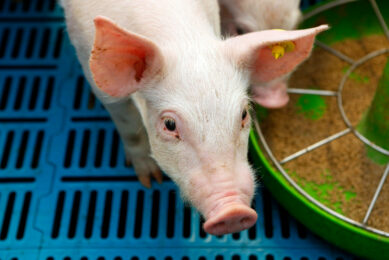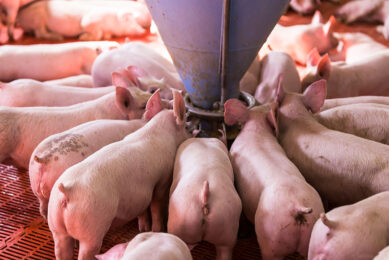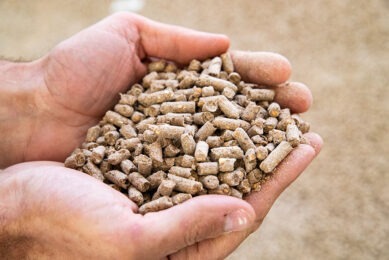Rabbits benefit from organic acid blend

On industrial rabbit-fattening farms, enteritis caused by Escherichia coli and Clostridium perfringens is a serious problem. Trials showed that a mixture of organic acids and essential oils might help to prevent this. Emmy Koeleman reports the results.
Intestinal diseases in rabbits resulting in diarrhoea are a serious economic threat, primarily in young weaned rabbits (four to ten weeks). Besides sanitary hygiene, these problems can be minimised by using certain feed additives that have a positive influence on gut microflora and its environment. Organic acids and plant extracts have already showed positive results in pigs and poultry. To test its efficacy in commercial rabbit production, several trials have been conducted since 2004 by the University of Perugia in Italy. Here we present, in short, two of the studies and their results.
Experimental set up
In 2005, a trial was carried out among 80 New Zealand White rabbits, which were weaned at 28 days old. The animals were divided into four groups (4 groups x 10 replicates x 2 rabbits per cage) and submitted to the following dietary treatments: Negative control (commercial diet without any supplement), diet 2 (commercial diet + 500 ppm of the antibiotic oxytetracicline + 200 ppm of the antibiotic tiamuline); diet 3 (commercial diet + 0.4% FormaXol – encapsulated source of formic acid with citric acid and essential oils in a powerful microgranule); diet 4 (basal diet + 0.5% Formyl – mixture of microencapsulated formic and citric acids). FormaXol and Formyl are produced by Soda Feed Ingredients. At 35 days of age all rabbits were experimentally infected with 109cfu Escherichia coli O103 and 109 cfu Clostridium perfringens type A and clinically monitored during four weeks. Thirty days after infection, 10 rabbits per group were euthanised and PCR was used for bacterial characterisation of bacterial presence in the intestinal tract. In 2006 a similar trial was carried out, but now also blood samples were taken before and after the infection to investigate non-specific immunity parameters (serum bactericidal activity and lysozyme) before infection and villi length was measured in the jejenum. In this study, 120 rabbits were split in three groups and received either diet 1 (commercial diet without any supplement), diet 2 (commercial diet + 150 ppm of the antibiotic zincbacitracin) or diet 3 (commercial diet + 0.4% mixture of microincapsulated formic acid, citric acid and essential oils).
Results from both studies
Data from the 2005 study showed that diet 1 was the only group where C. perfringens type A was detected. Diet 4 showed E. coli O103 in the animals. From the rabbits fed diets 1 and 2, E. coli strains different from O103 were isolated. No pathogen bacteria were detected in rabbits fed diet 3. This could indicate that the addition of a mixture of microincapsulated formic acid, citric acid and essential oils is more effective than the other used to prevent the growth of pathogen bacteria in experimentally infected rabbits. Mortality differed between the four diet groups. This data can be seen in Figure 1. The lowest pH of caecum content scored by both diet 3 and 4 (6.05 and 5.82 respectively) shows their ability to release most of the active ingredients in the hind gut allowing a reduction of the harmful bacteria and increasing the activity of the positive ones. The results from the 2006 trial showed that regarding average daily gain, animals in diet group 3 showed 27.1g growth per day against 26.1g in diet 2 and 25.9g in diet 1. Mortality figures showed that rabbits that received the zincbacitracin (diet 2) had the lowest loss of animals from 28 to 66 days (13% against 29% in the control diet and 21% in diet 3). The use of an organic acid mixture (diet 3) has shown to positively improve villi length in the small intestine (jejunum). 360.08 nm was measured against 304.51 in animals fed diet 2 and 269.43 in animals fed diet 1. Serum bactericidal activity measurements are an important parameter for understanding the non-specific immunity. Few days postinfection, diet group 3 showed a clear improvement of this parameter (Figure 2).
Lysozyme titres were also measures. Lysosme is an enzyme responsible for breaking down the polysaccharide walls of many kinds of bacteria and thus it provides some protection against infection. Normal values of lysozyme are around 20 mg/ml of serum. Samples from animals fed diet 2 and 3 were much lower than the control diet, which indicated that these animals showed a lower inflammatory response than the control animals.
Conclusions
The inclusion of organic acids and essential oils has a positive effect on the prevalence of Escherichia coli O103 and Clostridium perfringens type A in commercial rabbits. In addition, villi length, bactericidal activity responses and lysozyme titres seem to be positively influenced by the diets that included the organic acids and essential oils.
See Pdf version of article below.
Source: Feed Mix Vol 16 No 1











